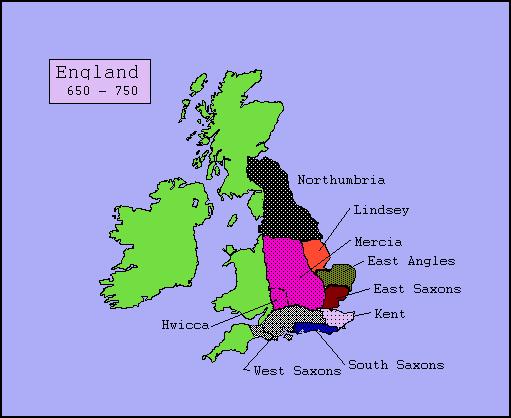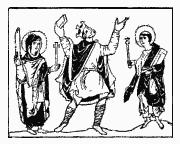Anglo-Saxon Warriors and Lords
This webpage was created for 7º Brit/Eur. Lit Ms. Ryan. Group members include: Alex, Zulma, Monica and Betty.

The above map shows the seven main Anglo-Saxon kingdoms.
Kent- modern county of Kent and South Eastern part of greater London, was under the rule of Mercian and then Wessex, until it was absorbed by Wessex.
Sussex- modern counties of East and West Sussex (minus the area around Hastings), was under the Mercian and then Wessex overlordship, until it was absorbed by Wessex
Wessex- mordern county of Hampshire and covered all the country south of the Thames River and from the borders of Kent and Sussex to the Tamar River, became the rulers of England in the 10th century
Northumbria- made up of two kingdoms (Diera, and Bernicia), sometimes ruled by one king or two kings, caused civil wars, suffered the most from Viking invasions
East Anglia- modern counties of Suffolk and Norfolk, may have been of Swedish descent rather than German or Danish
Mercia- the midlands from the Thames River to the Humber River, had power over almost all other kingdoms, split into two during Viking invasions
Essex- modern county of Essex and North Eastern part of greater London, under the rule of Mercian until Viking Invasions





 Dynasties did not last very long in this society because if the warlord/king wasn’t not strong enough to stay in power, their kingdom would last as long as they would. When new kings/warlords take over a kingdom, they must reassure the inhabitants that he would let them continue as they were (religion, way of life, etc.). They also had to make sure they were happy with him, otherwise he would get overthrown by his subjects. To ensure their power, kings/warlords aligned themselves with the Christian church because it made people believe that their god approved of this king, as seen above.
Dynasties did not last very long in this society because if the warlord/king wasn’t not strong enough to stay in power, their kingdom would last as long as they would. When new kings/warlords take over a kingdom, they must reassure the inhabitants that he would let them continue as they were (religion, way of life, etc.). They also had to make sure they were happy with him, otherwise he would get overthrown by his subjects. To ensure their power, kings/warlords aligned themselves with the Christian church because it made people believe that their god approved of this king, as seen above.




 Warriors pledged their loyalty to warlords or kings, and their lives to warfare. Dying in their sleep was something to be ashamed about, but dying in a battle was considered an honor. In return for their loyalty and services, gave food, lodging, clothing, supplied them with weapons, and rewards of land, gold, or jewelry. There were two main types of warriors.
Warriors pledged their loyalty to warlords or kings, and their lives to warfare. Dying in their sleep was something to be ashamed about, but dying in a battle was considered an honor. In return for their loyalty and services, gave food, lodging, clothing, supplied them with weapons, and rewards of land, gold, or jewelry. There were two main types of warriors.
Thane- professional warriors, hold land for their lords, or king, forerunner of knights
Ceorls- nonprofessional warriors, didn’t hold land for kings unless told to, had to hold enough land for five families (5 hides) in order to be updated a Thane




 Every free Saxon people, men and women, had the right to carry a seax, a dagger, while slaves did not. Different social classes carried different weapons while slaves did not.
Every free Saxon people, men and women, had the right to carry a seax, a dagger, while slaves did not. Different social classes carried different weapons while slaves did not.
Commoners- spears
 Farmers- wooden shields, iron/bronze boss, bows and arrows, protection gears: wool tunic and leather cap
Farmers- wooden shields, iron/bronze boss, bows and arrows, protection gears: wool tunic and leather cap




Professional warriors (thanes)- bow and arrows, spears, throwing axes, sword (shown above), shields, protection gears: mail shirts (shown above), cornical iron helmet




 Wergeld was a form of punishment that placed a price, that was determined by their social status, on everyone’s head. It lead to a court system where people had to prove their innocence by getting a large amount of people swearing that he/she was innocent. Since there was a value on everyone's head, one thane equaled to six ceorls!
Wergeld was a form of punishment that placed a price, that was determined by their social status, on everyone’s head. It lead to a court system where people had to prove their innocence by getting a large amount of people swearing that he/she was innocent. Since there was a value on everyone's head, one thane equaled to six ceorls!



 Information and pictures found on this page was also found on the following sites also:
Information and pictures found on this page was also found on the following sites also:
 www.octavia.net/anglosaxon/TheWarBand.htm
www.octavia.net/anglosaxon/TheWarBand.htm
 www.octavia.net/anglosaxon/TheWarKit.htm
www.octavia.net/anglosaxon/TheWarKit.htm
 www.angelcynn.org/uk
www.angelcynn.org/uk
 www.britainexpres.com/History/anglo-saxon_life-kingship_and_lordship.htm
www.britainexpres.com/History/anglo-saxon_life-kingship_and_lordship.htm
Main Page

Email: swtdrkangel@juno.com


















 Farmers- wooden shields, iron/bronze boss, bows and arrows, protection gears: wool tunic and leather cap
Farmers- wooden shields, iron/bronze boss, bows and arrows, protection gears: wool tunic and leather cap










 www.octavia.net/anglosaxon/TheWarBand.htm
www.octavia.net/anglosaxon/TheWarBand.htm www.octavia.net/anglosaxon/TheWarKit.htm
www.octavia.net/anglosaxon/TheWarKit.htm www.britainexpres.com/History/anglo-saxon_life-kingship_and_lordship.htm
www.britainexpres.com/History/anglo-saxon_life-kingship_and_lordship.htm